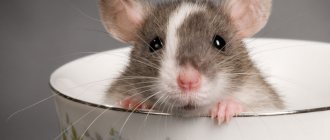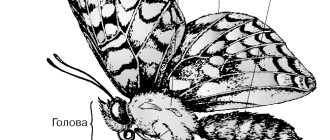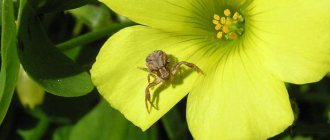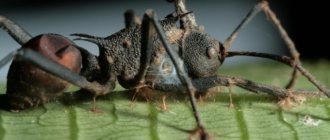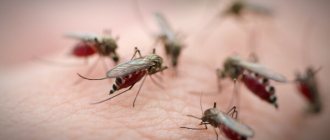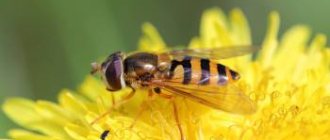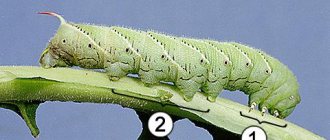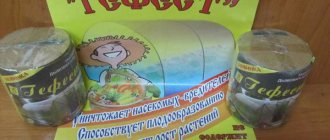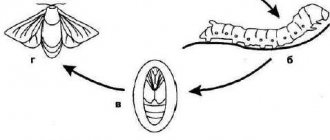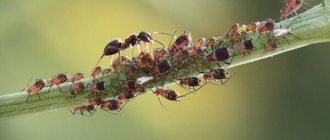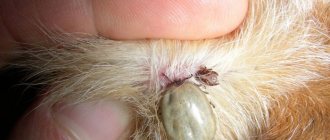The side-walking spider or crab spider is one of the most interesting species of the arthropod order.
Spider crab
Unlike his other brothers, he does not lure his prey into a web, but hunts by merging with the environment and adopting a motionless pose.
It immobilizes the victim by injecting poison into it. Eating pests, the crab spider is a welcome guest on farmland. Scientists are of great interest in the appearance of the side-walking spider and the life cycle of the small predator.
Appearance
The length of an adult female reaches up to 10 mm, and the male is only 3 - 5 mm. On the front part of the muzzle there are paired organs (Chelicera) no more than 0.3 mm in length, at their ends there are poisonous spines with which it digs into the body of the victim and sprays a poisonous venom that causes instant paralysis.
The pedipalps are located next to the chelicerae. They resemble a pair of hands with which he holds food while eating it; males also have genitals at their ends. They serve for him to transfer sperm to the female.
Different types of spiders can have different colors
, here are just a few that we would like to focus on:
- light;
- greenish;
- yellowish;
- less often, intense tones;
Note! That its color can change dramatically depending on the flower on which it is going to ambush in order to catch the victim.
Body structure
Body structure features are easier to analyze in the flowery yellow sidewalk spider (Misumena vatia). The name of the subspecies is explained by its habitat. Misumena most often lives on mushrooms and yellow flowers. These plants act as excellent camouflage from predators.
The body of a predator can be roughly divided into two parts connected by a small tube. The back row of eyes is wider than the front row. The hind eyes are widely spaced. The jaw is vertical, the segments are flattened and closely approximated.
The claws of the chelicerae are small but thick. Large venom glands occupy most of the cephalothorax and end behind the brain. Spider warts are found on the lower surface of the abdomen.
The male's body is usually covered with silky erect hairs. The knees are long, but thinner than the hips. The tibiae are almost cylindrical. The front pairs of legs are equipped with two rows of large ventral spines and smaller spines on the edges of the limbs.
Most of the representatives have a smooth body. Individuals are called “crabs” due to their characteristic limbs, which help them move not only forward, but backward and sideways.
The body is distinguished by the following features characteristic only of this species:
- the head and chest parts are located separately from each other.
- Two pairs of limbs are attached to the head. They have claws with poisonous glands.
- The tentacles are formed from six segments.
- On the frontal part there are 2 main eyes and 6 additional ones.
- The ability to move sideways is determined by the front pairs of limbs turned upward.
- All organs are located inside the oval-shaped abdomen, under which the genital opening is located.
- The front legs are 4-5 times longer than the rest.
- The body is very small in size, not exceeding 1 cm in females, 0.5 cm in males.
- It can change its color like a chameleon.
The structural features of the body help it deftly and imperceptibly make its way sideways between leaves and flowers, penetrate into a crevice in a tree, or run across to another surface.
Lifestyle
The side-walking spider is one of the few animals that does not weave webs; its huge advantages are:
- Powerful front legs;
- Ability to camouflage perfectly;
- Immobility;
Why, you ask, did we mention the word: “immobility”. Of course, camouflage is one of the most successful advantages that it uses during hunting, but immobility also plays an important role in the hunting process.
While scientists were observing different species of these spiders, it was recorded that a sitting spider on a red flower inflorescence had a white color and could successfully catch bumblebees, locusts, crickets, hornets, bees and flies. This makes it clear that its immobility during the hunt is as much an advantage as its camouflage.
Habitat
Sidewalk spiders do not like hot or cold climates. They prefer to live in mild temperate climates. They are not found in hot deserts or icy areas.
Trees, flowers and even soil become habitats for arthropods. A cocoon with larvae is placed on vertical surfaces - plant stems, flower leaves.
Some representatives of these spiders are limited to a specific area of residence. For example, the subspecies Xysticus sabulosus Hahn lives exclusively in lichens
Nutrition
Despite the fact that some spiders can pursue their prey, or wait for the moment when it itself falls into the web, our hero is much more cunning and does not intend to waste his energy on unnecessary movements.
In most cases, it climbs onto a flower, leaf or tree and hides in ambush, waiting for a potential victim. When an insect lands on a flower in search of nectar and approaches it, it instantly attacks it with its long legs and digs its poisonous spines (chelicerae) into its body.
The poison quickly affects the nervous system of the victim, as a result of which it remains motionless for a long time. In a short period of time, the spider sucks out the semi-digested food from it, and all that remains of the spoils is the devastated outer integument.
Peculiarities
Sidewalk spiders do not spin webs to catch flying insects. Female spiders make sacs from this sticky substance into which they lay their eggs. They also use webs to descend from taller plants to lower ones. But the most amazing thing is that with the onset of autumn they use it as a means of transport. Having ridden the bags, they are able to go on a long journey with the first gust of wind. In warm and dry weather, they cover a distance of several kilometers. Sometimes you can see a whole family of spiders on one web. To stop at a place they like, they simply shoot a web onto the nearest tree or plant.
Hunter Tactics
Despite their size, spiders are not afraid to attack larger insects. Like real hunters, they can sit in ambush for a long time, waiting for prey with open paws. As soon as a butterfly or wasp lands on a flower, they instantly grab them and bite them in vulnerable places. Having injected the poison, the flower spider begins to eat. However, if a hunter has not eaten for a long time, then his behavior changes radically. He runs restlessly through the leaves, looking for prey and moving his paws in anticipation of lunch. At the sight of an approaching insect, the spider freezes with its legs wide open. From the outside it seems that he opened friendly arms. Thanks to their coloring, they manage to remain unnoticed, and the tactic brings the desired result.
Reproduction
In early June, the mating season begins for sidewalk spiders. Males, like real gentlemen, court the female. If she considers the candidate worthy, then mating occurs. After a short break, the procedure is repeated, and after a while the female attaches cocoons wrapped in a web to the back of the leaves. Although this species does not tend to live surrounded by relatives, there are cases when a whole family of spiders lives on one plant.
Nutrition
Side-walking spiders are predators; they are not afraid to attack even insects larger than themselves. Spiders wait for their prey for a long time, camouflaging themselves with the terrain (flowers, soil, bark). Side-walking spiders are very mobile and when the long-awaited profit appears, they quickly grab it with their feet and inject their paralyzing venom into the body of the victim. Then, after some time, all the nutrients are sucked out of it, leaving only one shell.
Reproduction
The breeding season is early or mid-summer. All adult males have mandatory devices at the end of the pedipalps related to special genital organs.
They use them to collect sperm and transport it to the female’s genital opening. To carry out fertilization, the male needs to slowly approach the female at a close distance, but he is at great risk, as he may be eaten.
The fact is that females have much worse vision than males, so when a male approaches her, she can thrust her poisonous “chelicerae” without understanding the silhouette approaching her.
Females of other species can behave friendly towards males, so they can calmly approach them for mating, while trying to stroke them with their paws, thereby stimulating her to have sexual intercourse.
The lion's share of females of all species try to eat the male after copulation, but some males manage to avoid attack by using tactics that block the female's legs and her poisonous chelicerae.
After fertilization, the female carries eggs, which are hidden in a cocoon. After two or three weeks, small spiders hatch from the eggs. Before puberty, they are able to molt several times.
Features of behavior
This is one of the spiders found in Australia. Lives among plants and trees. Spends most of its time on the leaves, waiting for prey. The crab spider does not weave trapping nets; it uses the web to move over long distances and neighboring branches.
The predator behaves carefully and does not reveal its presence with unnecessary movements. Sits motionless in ambush or guards a clutch of eggs. When he sees the victim, he takes a stance “with open arms” and waits for the right moment. Almost at lightning speed he rushes to attack, bites, injects poison.
Interesting!
In pursuit of prey, the huntsman can develop high speed, move sideways in different directions, and jump.
The giant crab spider feeds on insects, small relatives, lizards, frogs, and even rodents. Along with the poison, the predator injects saliva, which turns the insides into a liquid mass in a few minutes. The hunter feeds on it.
This is interesting
Crab spiders master the art of camouflage, so it will be extremely difficult to detect it on a flower. It can instantly change its color and blend in with its surroundings.
If you look closely, you can see cabbage butterflies or urticaria butterflies sitting in one place for a long time, this may mean that they fell into the cruel paws of this spider.
By nature, he is not able to chew food, so he tries to suck out the insides of insects. From the outside you might think that the butterflies are alive, but in fact, these are mummies left over from them.
The side-walking spider is deadly to humans - truth or myth?
These representatives of the arthropod family secrete a very toxic poison that almost instantly immobilizes the victim.
Sidewalk spider on the hunt
And here a completely logical question arises: “Is the side-walking spider dangerous or not for humans?”
The arthropod is not dangerous to humans for several reasons:
- it does not attack people:
- the concentration of poison in such a minuscule creature is even more minuscule;
- this amount of poison is not even enough to paralyze a pet.
Only small representatives of the animal world (hamsters, mice, rats, etc.) can feel its influence.
Conclusion
By looking at the photo of the side-walking spider, you can appreciate the diversity of these representatives of the fauna.
The coloring of the body, merging with the environment, leaves them invisible not only to potential victims, but also to the human eye.
And since the food for the predator is mainly pests of garden crops, crab spiders bring undeniable benefits to humanity.
Interesting Facts
- While the female is eating, the male can fertilize her and quickly hide so as not to become her lunch.
- A spider caught by the front leg can throw it off and free itself, but it may become a less successful hunter.
- Scientists were able to observe how a side-walking spider, measuring nineteen millimeters in size, ate a praying mantis, whose body length was about 78 mm.
- It can easily move sideways, thereby justifying its name.
- From the outside, its body shape and forelimbs may resemble a common sea crab.
Varieties
Sidewalk spiders are terrestrial animals. They are found everywhere on the globe. In warm climates, species diversity is much wider than in temperate and cold climates.
Spiders adapt to climatic conditions in various ways. One of them is coloring. All varieties of bocod spiders have their own shade. This family has 170 genera, in which about 2000 species are distinguished. The most studied types are:
Flower spider (Misutnena vatia)
- color white, yellowish;
- body size up to 11 mm;
- lives on flowers of the ranunculaceae and cornflower family;
- food: butterflies, bumblebees, bees;
- Habitat: Europe, North America.
Yellow crab spider (Xisticus luctuosus)
- the body of the male is dark brown, 4-5 mm long, the female is yellow – 7-8 mm;
- lives in meadows and forest clearings;
- distributed in the European part of Russia and the former USSR.
Ornamented blueberry (Synaema ornatum)
contrasting color: the bottom of the abdomen is black, the top is red or yellow with a black angular spot;
- body length of a male is 5-6 mm, female – 7-8 mm;
- lives on flowers of the Rosaceae family;
- feeds on insects;
- lives in the steppe and forest-steppe of our country.
The corn borer is a pest of corn, millet, barley and sunflower. There are two types of pyavits: red-breasted and blue. You will find a detailed description of the insect in this article.
Swedish fly control measures must be comprehensive if you want to achieve an effective result. Read more about fighting methods at the link.
Social structure
The crustacean reaches sexual maturity by 10 years. At the legislative level, there is a ban on catching spider crabs in the spring, as well as from the beginning of winter to April. During this period, animals actively mate, and the restriction makes it possible to maintain the population and increase the number. Mating occurs once a year, and the female can lay up to 1,000,000 eggs.
Fertilized eggs, which are attached to the abdominal appendages, hatch into small planktonic larvae. Their development interval lasts from 50 to 80 days. The larvae resemble plankton in appearance: small, transparent, drifting on the water surface. The development of larvae occurs in stages: at the larval stage they live in shallow depths, and as they grow up they go into deep waters.
Let's discuss the results
In the experiment, we see a clear preference by spiders for different parts of the cage, but not for colored samples located at its bottom. Probably, attractant phototaxis was observed in spiders (in simple terms, movement towards light). Spiders often occupied a place that was facing a natural light source (that is, crawling towards the window). Every day, the cages were rearranged in a random order and turned 90 degrees (clockwise). However, the spiders still invariably chose a certain side. However, spiders were not associated with a specific color. It follows that the data obtained under artificial conditions are not similar to the choice of spiders under natural conditions. Interestingly enough, spiders change their preferences in an artificial environment. Of course, this can be attributed to the fact that cardboards cannot be identical to plants. However, in one experiment (not described here), we offered dried wildflowers (cornflower, tansy, groundsel, and yarrow) to spiders in cages, but the subjects were still more likely to sit on the walls or on the lid of the cage rather than on the plants. Of course, for greater statistical reliability it is necessary to conduct many more experiments. Therefore, we consider it our goal to repeat the experiments many times and obtain additional data that will help us finally understand the problem of how the flower spider chooses its favorite flower. The research methodology will be further refined. We will try to bring the artificial conditions of keeping eight-legged creatures closer to natural ones. Perhaps if spiders are provided with conditions closer to natural conditions, their choice will be different.
I express my deep gratitude to Vladimir Mikhailovich Kartsev, Rimma Ravilyevna Seifulina, Alexander Viktorovich Sharikov, Andrey Vitalievich Naumov and Konstantin Arutyunovich Magaryan for the data provided and comments made!
Where does it live?
In the waters of the Pacific Ocean, in the areas of the islands of Honshu and Kyushu. For life, it prefers a sandy, rocky bottom, up to 200-300 m deep. Crustaceans hide in ocean vents and holes at great depths. Tolerates fairly low temperatures. Found in Suruga Bay, spider crabs live there at a depth of 200 meters at a temperature of 10 degrees Celsius. A person cannot catch them in the water, since the animals try to get as deep as possible. Crabs placed in public aquariums tolerate temperatures ranging from 5 to 15 degrees Celsius. Juveniles prefer warmer temperatures.
Recommendations for a bite
Sidewalkers rarely attack humans. Their bites are not particularly dangerous, but they cause discomfort.
Symptoms of a sideworm bite:
- slight red swelling of the affected area;
- itching and burning;
- pain in the head, malaise, dizziness;
- general weakness.
For treatment, it is recommended to use ice by placing it on the affected area. Antihistamines will come to the rescue. The bite area is treated with “Asterisk” ointment. It should be remembered that this species has poisonous glands.
